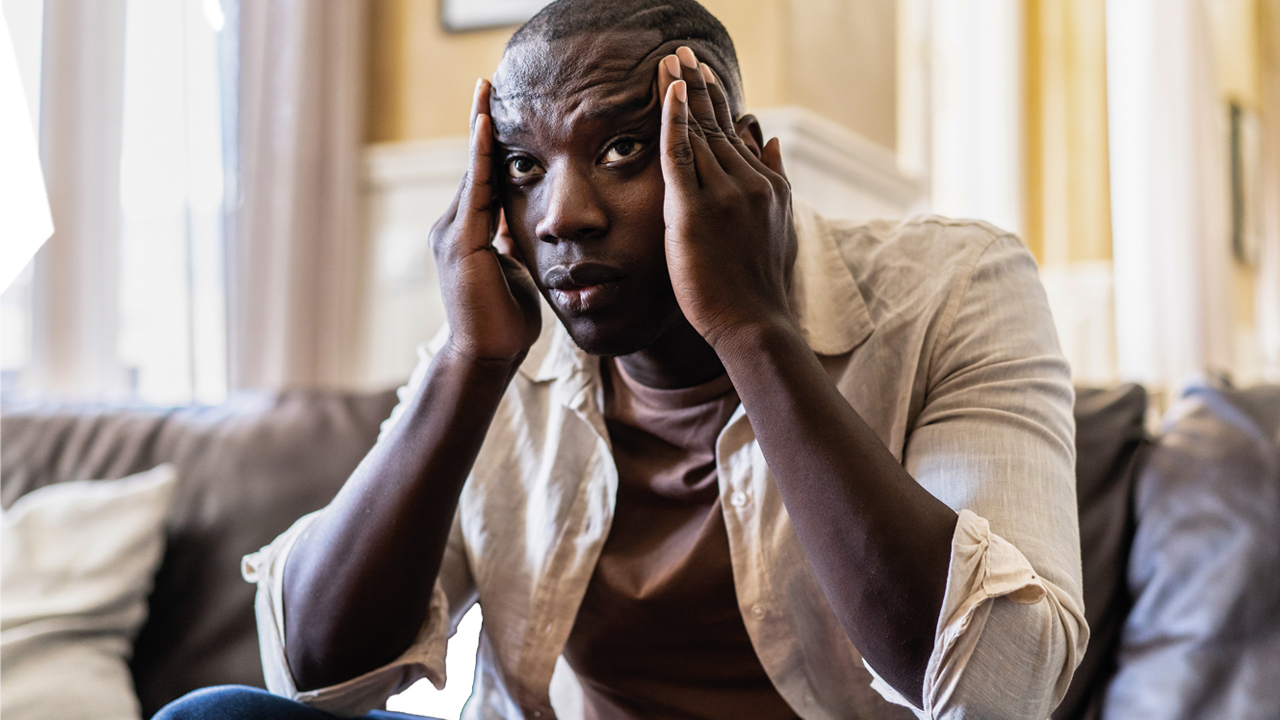In OTC
Follow this topic
Bookmark
Record learning outcomes
Most people experience a headache from time to time and many usually ease on their own or with simple self-help measures and aren’t anything to worry about, but they can still cause significant pain and discomfort. How people ease the symptoms often depends on the type of headache, its severity and its frequency. According to the British Association for the Study of Headache (BASH) 2019 guidelines, most headaches are primary headaches. This means they’re not associated with another medical condition. The most common types of headaches are tension-type headaches, migraine (see panel) and medication overuse headaches. It’s important to try to identify key headache triggers by keeping a symptom diary. “Identifying triggers can play a significant role in reducing headache frequency and intensity,” says Dr Johannes Uys at Broadgate GP. “Tension headaches often stem from stress, poor posture or muscle tension, while migraines are usually triggered by various factors such as hormonal changes, certain foods or sensory stimuli.”
If head pain and any associated symptoms are severe, more frequent or unusual, it’s important to seek medical advice to rule out secondary headaches caused by another condition. Many people worry that regular headaches are due to a brain tumour or high blood pressure, however, most headaches don’t have an underlying cause. Brain tumours are very rare, and high blood pressure doesn’t usually cause any symptoms at all.
Feel the tension
Tension-type headaches are the most common type of primary headaches, affecting over 40 per cent of people at some point in their lives. Unlike migraine headaches, tension-type headaches don’t get worse on movement and aren’t usually accompanied by nausea or light/noise sensitivity. Stress, anxiety and depression are common triggers.
“The symptoms include a pain on both sides of the head, face or neck and feeling like something is pressing or being tightened around the head,” says George Sandhu, deputy pharmacy superintendent at Well Pharmacy. “The affected area can often feel tender, and your head may hurt more when touched.” Acute tension-type headaches can last from half an hour to several days. They can usually be eased with over-the-counter (OTC) painkillers, such as paracetamol and ibuprofen. “Over-the-counter medicines can provide relief for some types of headaches, but they should be used carefully and as directed to avoid side effects or potential overuse,” says Kenny Chan, Numark lead information services pharmacist. “Other OTC products that can be used for headaches include rubs c-ontaining menthol, which are applied directly to the forehead, and cooling patches/pads.”
Self care tips for tension-type headaches include:
- Getting enough sleep
- Taking regular screen breaks during the day
- Taking regular exercise
- Improving sitting and standing posture
- Drinking plenty of fluids
- Avoiding or limiting alcohol and caffeine
- Applying a cold compress over the eyes or forehead
- Using lavender oil
- Having a warm bath or shower
- Trying relaxation techniques, such as mindfulness and breathing exercises.
If tension-type headaches occur on 15 or more days each month for at least three months, this is called chronic tension-type headache. It’s often caused by muscle tension in the back of the neck and may initially be triggered by tiredness or sitting awkwardly at a computer. Acupuncture and massage may help to prevent chronic tension-type headaches, or a GP may prescribe low doses of the antidepressant amitriptyline. Chronic headaches may also be a sign of medication overuse.
“Identifying triggers can play a significant role in reducing headache frequency and intensity”
In overdrive
Medication overuse headache is caused by taking painkillers too regularly or for a long time, usually to relieve headaches. People who suffer with medication overuse headaches may become tolerant to painkillers, which means the painkillers no longer work as they used to. They keep taking more and more painkillers to help them feel better, but this actually makes their headaches worse – often called rebound headaches.
Medication overuse headache affects up to two per cent of adults with acute headaches, and up to 50 per cent of people with chronic headaches (usually tension-type headaches or migraine). Any painkillers can trigger medication overuse headache, including paracetamol, ibuprofen, aspirin and codeine, if these are taken for 15 days or more in one month. Combination painkillers may cause rebound headaches when taken on 10 days or more in one month. Triptans may be even more likely to trigger medication overuse headaches. “These headaches usually begin early in the day and persist throughout the day,” says Kenny. “They may be accompanied by other symptoms such as restlessness, difficulty concentrating and memory problems.”
The only way to stop medication overuse headache is to stop taking the painkillers completely and find other ways to relieve acute headaches or to use preventative treatments. Stopping the painkillers may cause withdrawal headaches for up to 10 days, and it can take up to three months for the headaches to disappear completely.
“Migraine affects 10 per cent of men and 22 per cent of women”
Managing migraine
According to the British Association for the Study of Headache (BASH), migraine affects 10 per cent of men and 22 per cent of women. It’s most common in people aged 25-55. The moderate to severe throbbing headaches tend to affect one side of the head only and are often severe enough to limit activity and affect daily life. The headaches are often associated with nausea and vomiting, dizziness and extreme sensitivity to light, noise and/or motion. A migraine attack can last from four to 72 hours. Some people get a migraine attack once a year, while others have an attack several times a month. Before a migraine headache, some people experience ‘premonitory symptoms’ including feeling tired, difficulty concentrating and a stiff neck. Around one third of people with migraine experience an aura before or during the headache. Some people only get the aura – they don’t get the headache at all. Women who experience migraine with aura have an increased risk of stroke if they take oestrogen-containing contraceptives. “Migraine with aura can be very disturbing as symptoms include visual disturbances (flashing lights, blind spots), numbness or tingling, difficulty speaking, followed by a headache with throbbing pain,” says George Sandhu, deputy pharmacy superintendent at Well Pharmacy. “Aura should not last for more than an hour.” Some people can work out their specific migraine triggers. Common triggers include stress, anxiety, sleep disturbance, hormonal changes, dehydration, skipping meals, some foods and medicines, and bright lights or loud noise. In other people, a combination of triggers leads to an attack, and this is more difficult to pinpoint. Mild migraine can often be treated with simple painkillers, such as ibuprofen or paracetamol. It’s important to take the painkillers early on in a migraine attack – soluble products may be more effective and act more quickly. Customers may also be able to ease a migraine attack by lying down in a dark, quiet room, placing an ice pack or cold cloth on their forehead, and drinking plenty of water. If this fails to work, a GP will usually prescribe triptans, such as sumatriptan. Triptans are also most effective when taken early during a migraine headache. Taking a prescribed antiemetic (anti-sickness medicine) such as metoclopramide not only helps to manage any nausea and vomiting but can also improve the absorption of painkillers.
Chronic migraine affects around two per cent of the population. It’s diagnosed as a headache on 15 or more days a month for three consecutive months, of which at least eight days have features of migraine. Preventative medicines, such as topiramate, propranolol or amitriptyline, may be prescribed by a GP to prevent regular attacks in people with four or more migraine days a month. An external trigeminal nerve stimulation device (Cephaly) may also help to prevent and treat migraine.

Sinus of the times
As their name suggests, sinus headaches are caused by sinusitis (swelling of the lining of the sinuses). Other common symptoms of sinusitis include a blocked or runny nose, a cough, a feeling of pressure in the ears and a fever. Acute sinusitis is often triggered by an allergy or viral infection, while chronic sinusitis may be caused by an allergy or acute sinusitis that hasn’t cleared up. Sinus headaches are usually felt as dull pain at the front of the head on both sides. They may initially be mistaken for migraine, which typically affects one side of the head only. Sinus pain may also affect other parts of the face, including the jaw and teeth. This may be worse when moving or bending over. The face may feel tender when touched, especially just below the eyes or around the nose. “Sinusitis is one of the conditions treatable through the Pharmacy First service,” says George. “Over-the-counter treatments include decongestants, saline nasal sprays, antihistamines if the symptoms are being caused by an allergy, and OTC pain relief. Pharmacy staff can also advise customers to stay hydrated and apply warm compresses to the affected area.”
Atogepant on the NHS
In May 2024, the National Institute for Health and Care Excellence (NICE) announced its approval of the first oral treatment on the NHS in England to prevent both chronic and episodic migraine in adults. Atogepant, which comes in tablet form, is being recommended as a daily treatment for people who have at least four migraine days a month and who haven’t responded well to three other migraine treatments, including injections and infusions. Atogepant is already approved as a preventative migraine treatment in Scotland. It works by inhibiting the function of calcitonin gene-related peptide (CGRP), a natural substance in the body that causes migraine attacks. At first, atogepant will only be available from specialist doctors in secondary care settings in England, rather than from GPs. According to NICE, it should be stopped after three months if there is no significant reduction in the frequency of migraine attacks.
Cluster headaches
According to BASH, cluster headaches affect around one in every 1,000 people. “The exact cause of these is unknown,” says George. “They’re more common in men in their 30s and 40s, or if you have other sufferers in the family. If someone suspects they have cluster headaches, or painkillers such as paracetamol or ibuprofen don’t help their headaches, they should be referred to the GP. There is no cure for cluster headaches, but a specialist may recommend some suitable treatments.” The main symptom of cluster headache is a disabling one-sided headache that starts and stops quickly. Many people describe a cluster headache as the worst pain they have ever felt – a sharp, piercing pain. They can’t stay still during an attack, often pacing around the room. In contrast, people with migraine tend to prefer to stay still during a migraine attack.
A cluster headache can last anywhere between 15 minutes to three hours. The headaches often wake people in the night, usually one-and-a-half to two hours after they have fallen asleep. “These headaches are usually focused around one eye,” says Kenny, “and that eye may be red and watery with a droopy eyelid.” The headache attacks occur in active cycles, called clusters, often at set times every day for a number of days or even weeks. Between these headache attacks, people may experience a dull background headache. Some people find that alcohol triggers a headache attack, usually within an hour. The headache cluster then disappears for months on end, leaving people pain-free but exhausted – each cluster tends to be seasonal and occurs at the same time each year. Episodic clusters usually last between two weeks and three months, and usually return every one to two years. Chronic clusters usually have no remission period, or the remissions may last from less than three months to one year. OTC painkillers don’t ease cluster headaches, so prescription medicines are required. Sumatriptan injections or nasal spray are the most effective acute treatment, usually providing relief within 15 minutes. High flow 100 per cent oxygen through a mask for 15 to 20 minutes may also stop an acute attack. Some people use a handheld electrical device called gammaCore to stimulate the vagus nerve in the neck as an acute or preventative treatment. Other preventative treatments include the medicine verapamil and an injection into a nerve at the back of the head (called a suboccipital nerve block).

Other types of headaches
- Withdrawal headaches can be a response to reducing caffeine intake, drinking alcohol (the morning after), not drinking enough fluids, and carbon monoxide exposure
- Hormone-related headaches (also called menstrual headaches) often develop in the two days before or three days after a period begins, or occasionally during ovulation. The symptoms are similar to migraine without aura (see the panel). These headaches can also occur in people taking oral contraceptives, during pregnancy or during the menopause
- Exertional headaches are associated with strenuous activity, including exercise, coughing, having sexual intercourse or even straining with bowel movements
- Thunderclap headaches start very suddenly. The severe pain is at its worst within around one minute, while the whole headache lasts for at least five minutes. It’s important to seek immediate medical advice, because thunderclap headaches are often caused by a serious underlying health condition, such as a brain haemorrhage.
Red flags
It’s important that pharmacy customers are referred to their GP for headaches if:
- There has been a significant head injury in the previous three months
- The headaches are getting worse and are accompanied by a fever
- There are also problems with speech, balance, memory, confusion, or personality or behavioural changes
- The headache started on coughing, sneezing or straining, or worse when sitting or standing
- The headache is associated with red or painful eyes or unexplained vomiting.

